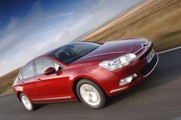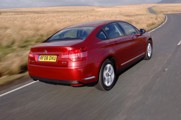Review
The Citroën C5 has provoked a fair degree of interest in the motoring press recently, mostly involving the phrases “German quality” and “French flair”.
Such statements accurately reflect the hopes of the French carmaker, which wants to revitalise its fleet presence with the new C5, its answer to the likes of Volkswagen’s Passat and Ford’s Mondeo.
Historically, Citroëns have been all about Gallic swishness, but have lacked the build quality and general feeling of indestructibility that tends to accompany cars from Germany.
The C5 is touted as being the best of both worlds. Can it deliver?
Initial impressions are good.
The car certainly stands out from the ranks, with some striking lines.
The bonnet is stretched taut over two rising spines level with the headlights, and similar lines run down the flanks, giving a muscular look to the Citroën family face most recognisable from the C4.
The design inside is also pleasant on the eye, particularly the dashboard instruments, which pack a lot of information into three aviation-inspired dials.
At night, the whole dash console is lit by a reddish-orange glow that also emanates from under the glovebox.
There are plenty of other nice touches, too.
The door pockets have a motion sensor in them that switch on a light to help you see what you’re grabbing for in the dark.
The car I drove had optional electric front seats that include a massage feature.
These work surprisingly well, gently pummelling the lumbar region. Great for long journeys, but possibly not great enough to justify the £1,550 asking price.
Build quality is dramatically improved on previous Citroëns, and the quality of materials used is excellent.
However, the C5 is not as practical as it is pretty.
Firstly, the cupholders.
It’s not unreasonable to expect drivers to want a drink during long hours on the road.
Why then, is the one and only cupholder located under the armrest?
It means you can’t keep anything in the storage space in case you want a drink, and also means you can’t rest your arms while you have a drink on the go.
Secondly, the hands-free phone. In an age where even the Ford Fiesta is available with a Bluetooth connection, why does Citroën insist on forcing drivers to take their phone apart, remove the SIM card and then break their nails trying to get a microscopic SIM-carrying drawer out of the dash?
Rant over.
On the move, the C5 is very good.
The 138bhp diesel engine barely purrs as it wafts you along in the way that only Citroëns can waft. It’s not fast – 62mph takes 11.6 seconds to reach – but it’s as smooth as double cream.
Through the corners, there’s a fair amount of rocking and rolling about, but there is nimbleness in the chassis, like a former heavyweight boxer who still has twinkle in the toes.
Citroën has taken a big leap forward with the C5.
The build quality is better, if not quite on par with its Teutonic rivals, but it’s much more stylish and very comfortable, occasional niggles aside.
It could be a real contender.
Positive:
Looks
Build quality
Comfort
Negative
Cup holders
Fiddly hands-free kit
Wallowly cornering
THREE RIVALS TO CONSIDER
- Ford Mondeo 2.0 TDCi Zetec 5dr
- Mazda6 2.0d TS2 5dr
- Volkswagen Passat 2.0 TDI Highline
P11D PRICE
Less than £1,000 separates the most expensive from the cheapest, and all are very similarly specced. The Passat is the priciest, but comes with leather seats and cruise control as standard. The rest have cloth upholstery, and only the Volkswagen and Mazda have 17-inch alloys.
Mazda6: £18,255
C5: £18,305
Mondeo: £18,705
Passat: £19,215
EMISSIONS AND TAX RATES
The Mazda sneaks under the 150g/km mark, which puts it into a lower band than its rivals.A 20% company car taxpayer would have the lowest bill with the Mazda at £60 a month. The Passat’s monthly bill is £64, while the Ford and C5 are £68 and £67 respectively.
Mazda6: 149g/km/20% £60
Passat: 153g/km/21% £64
C5: 157g/km/22% £67
Mondeo: 156g/km/22% £68
SMR COST
Despite having 17-inch wheels and hence higher tyre costs, the Passat is the cheapest to maintain over a fleet life of three years/60,000 miles. The Volkswagen has variable servicing, while the Mazda and Ford have slimline 12,500-mile intervals. The C5 needs attention every 20,000 miles.
ppm/60k total
Passat: 3.27/£1,962
Mondeo: 3.77/£2,262
C5: 3.86/£2,316
Mazda6: 4.38/£2,628
FUEL COST
The Citroën is the thirstiest of this quartet, with a combined mpg of 47.1. It will cost an extra £400 to run over a three-year/60,000-mile fleet life than the most frugal car, the Mazda. It has an mpg of 50.4, while the Passat manages 48.7 and the Mondeo 47.9.
ppm/60k total
Mazda6: 9.86/£5,916
Passat: 10.21/£6,126
Mondeo: 10.38/£6,228
C5: 10.55/£6,330
DEPRECIATION COST
Residuals are not Ford’s strong point due to the volumes it sells. With CAP estimating an RV of 33% after a three-year/60,000-mile fleet life, it’s in last place. The Passat benefits from Volkswagen’s brand image, with an RV of 41%. The C5 and Mazda are on 37%.
ppm/60k total
Passat: 18.56/£11,136
C5: 18.96/£11,376
Mazda6: 19.13/£11,478
Mondeo: 20.88/£12,528
WHOLELIFE COST
It might be the most expensive car to buy, but rock-solid performances in other areas mean the Passat is the cheapest to run over a typical fleet life. The Citroën and Mazda will cost exactly the same as each other, while the Mondeo’s RVs let it down and leave it almost £1,000 adrift.
ppm/60k total
Passat: 32.04/£19,224
C5: 33.37/£20,022
Mazda6: 33.37/£20,022
Mondeo: 35.03/£21,018
Verdict
With Volkswagen’s new Highline edition offering a stack of extra kit as standard, the Passat proves a strong match for the other cars.
Yes, it’s getting on in years, but its equipment list is now bang up to date and the base car is a very competent one. With typically strong Volkswagen residuals, cheap SMR costs, decent fuel economy and acceptable emissions, the Passat is the one to go for.
The Citroën is a huge improvement over its predecessor and does extremely well to be on a par with the Mazda6 in second place.
The Mondeo is a great car, possibly the best car to drive here, but it can’t compete on price.
- WINNER: Volkswagen Passat 2.0 TDI Highline


















